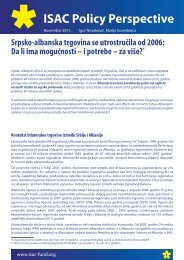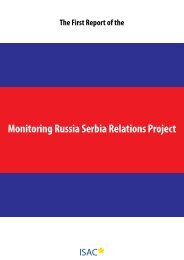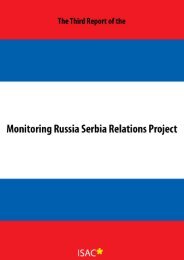the process of security sector reform - ISAC Fund
the process of security sector reform - ISAC Fund
the process of security sector reform - ISAC Fund
Create successful ePaper yourself
Turn your PDF publications into a flip-book with our unique Google optimized e-Paper software.
István Gyarmati MILITARY REFORMS OF THE 1990s: LESSONS LEARNED FROM THE SUCCESSES AND FAILURES<br />
István Gyarmati MILITARY REFORMS OF THE 1990s: LESSONS LEARNED FROM THE SUCCESSES AND FAILURES<br />
necessary mix <strong>of</strong> long-term commanders and experts and shorter-term foot<br />
soldiers. All <strong>of</strong> this must be achieved in strong competition with o<strong>the</strong>r employers<br />
in a competitive labor market.<br />
5. The military budget: matching resources to missions and ensuring transparency<br />
The military budget is an essential element <strong>of</strong> <strong>reform</strong>: budgetary means available<br />
must be sufficient or o<strong>the</strong>rwise <strong>the</strong> <strong>reform</strong> will fail. A failed <strong>reform</strong> produces<br />
worse results <strong>the</strong>n no <strong>reform</strong>, <strong>the</strong>refore it must be approached with extreme care.<br />
This is not to suggest that all requirements, expectations, demands and wishes<br />
<strong>of</strong> <strong>the</strong> military must be fulfilled. Sufficiency <strong>of</strong> means, in this context, means<br />
that only those objectives can be set which are supported by budgetary means.<br />
Should <strong>the</strong> budget be limited, <strong>the</strong> objectives should also be limited: balance is<br />
essential.<br />
It is also important to ensure that <strong>the</strong> budget be transparent. The budget is one<br />
<strong>of</strong> <strong>the</strong> most important means in <strong>the</strong> hands <strong>of</strong> <strong>the</strong> political leadership, including<br />
<strong>the</strong> executive and <strong>the</strong> legislative, to exercise control over <strong>the</strong> military. It is<br />
also essential in terms <strong>of</strong> establishing and maintaining pubic support, which is<br />
indispensable for <strong>the</strong> <strong>reform</strong> and <strong>the</strong> long-term maintenance <strong>of</strong> defense forces<br />
in any one country.<br />
As mentioned above, <strong>the</strong> budgetary system should provide clear information<br />
about what different military capabilities cost in reality and in <strong>the</strong>ir entirety. This<br />
will make budgetary decisions easier to make, since decision-makers − and <strong>the</strong><br />
public − will know what are <strong>the</strong> real consequences <strong>of</strong> cuts or increases. Not only<br />
does transparency enable <strong>the</strong> political leadership to make decisions based on<br />
more complete information, it also places <strong>the</strong> responsibility for <strong>the</strong>se decisions<br />
where it belongs: on elected politicians. This relieves <strong>the</strong> military <strong>of</strong> taking<br />
decisions which must be reserved for <strong>the</strong> political leadership and Parliament.<br />
6. Pursue technical modernization, but at <strong>the</strong> right time<br />
Technical modernization is an important element <strong>of</strong> <strong>reform</strong>, but it is not <strong>the</strong><br />
<strong>reform</strong> itself. The military tends to equate modernization with <strong>the</strong> acquisition <strong>of</strong><br />
new weapons and o<strong>the</strong>r systems: this is simply not true. Technical modernization,<br />
<strong>of</strong> course, is an important pre-requisite for establishing and maintaining modern<br />
armed forces. Technology, however, can only work if <strong>the</strong> environment is capable<br />
<strong>of</strong> using it properly. This means that <strong>reform</strong>s aimed at <strong>the</strong> “s<strong>of</strong>tware”<br />
<strong>of</strong> <strong>the</strong> military (training, doctrine, etc.) must precede technical modernization,<br />
o<strong>the</strong>rwise <strong>the</strong> old structures will never be able to make use <strong>of</strong> new technology.<br />
Pursuing technological modernization too early is counterproductive: on <strong>the</strong><br />
one hand it diverts financial resources from o<strong>the</strong>r areas, like personnel; on <strong>the</strong><br />
o<strong>the</strong>r hand, it creates <strong>the</strong> impression that <strong>reform</strong> is indeed happening and thus<br />
provides an excuse not to do anything else.<br />
7. Make a careful decision regarding conscription vs. all-volunteer forces<br />
The decision between conscription or all-volunteer armed forces is an important<br />
one: public pressure will mount in every democracy to get rid <strong>of</strong> conscription.<br />
This is also supported by pr<strong>of</strong>essional arguments: modern armed forces hardly<br />
can rely on short-term conscripts. An all-volunteer force is, however, very<br />
difficult to establish and maintain. It is expensive. It requires a real sense <strong>of</strong><br />
purpose <strong>of</strong> <strong>the</strong> force to be able to recruit <strong>the</strong> necessary quality and quantity <strong>of</strong><br />
personnel, and it necessitates very strong political control in order to ensure that<br />
<strong>the</strong> forces never act on <strong>the</strong>ir own. This decision should not be taken hastily. All<br />
<strong>of</strong> <strong>the</strong> pros and cons must be considered, including <strong>the</strong> budgetary implications.<br />
Moving to an all-volunteer force must not be seen as a way to save money!<br />
LESSONS FROM THE EXPERIENCES<br />
OF OTHER COUNTRIES:<br />
1. For a defense <strong>reform</strong> to succeed, national consensus on its main objectives<br />
and some essential elements is indispensable. The consensus must<br />
include rough forecast for military spending and should cover <strong>the</strong> most<br />
important elements <strong>of</strong> <strong>the</strong> <strong>reform</strong>.<br />
2. Defense <strong>reform</strong> cannot be elaborated by <strong>the</strong> military: <strong>the</strong> <strong>process</strong> must be<br />
driven by <strong>the</strong> political/civilian leadership. It must, however, not alienate<br />
<strong>the</strong> military ei<strong>the</strong>r. This does not mean, however, that one should require<br />
<strong>the</strong> support <strong>of</strong> recent senior military for <strong>the</strong> <strong>reform</strong>s: it would be irrational<br />
to expect military leaders educated in ano<strong>the</strong>r system to be open to<br />
radical <strong>reform</strong>. It is <strong>the</strong> second and third level <strong>of</strong> military leaders, who<br />
will support <strong>reform</strong>, if – and that is ano<strong>the</strong>r essential requirement – <strong>the</strong><br />
<strong>reform</strong> <strong>of</strong>fers <strong>the</strong>m a perspective <strong>of</strong> a better military and a better life.<br />
76 77

















